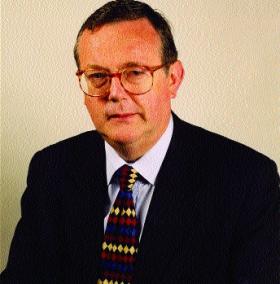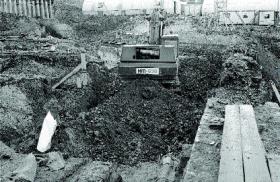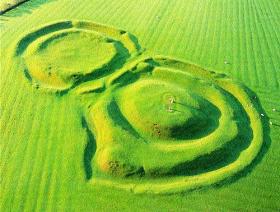Wood Quay Man
Published in Features, Features, Issue 5 (Sep/Oct 2005), Volume 13 TC: Perhaps we can begin by asking you to tell us something about your background.
TC: Perhaps we can begin by asking you to tell us something about your background.
PW: I was born in Askeaton, Co. Limerick, 56 years ago. In 1966 I got a scholarship and chose to go to University College Galway. If it had not been for the scholarship I doubt that I would have got to university then. I studied history and archaeology. Although I preferred archaeology, I did better in history exams. So it was that my original postgraduate work was in history. Then in the autumn of 1971 I was offered a job here in the National Museum as an archaeologist, and so unfortunately my historical research had to be put aside.
TC: What was the work here like?
PW: It was a grind. The National Museum is not primarily a research institution, much as we would like it to be. I had to do the day-to-day archaeological investigations, the accessions and so on. Eventually, when I was only 25 I got responsibility for the Wood Quay site. I hadn’t much experience at that stage but the Director and Keeper of Archaeology of the day trusted me. I was a company man, as I still am, and they knew I would do a good job. That developed into a £2 million six-year campaign, which I regarded as a £2 million scholarship despite all the pain and all the agony. Because I knew that I was sitting on a gold-mine. Wood Quay has made my life and my career, for good or bad.
TC: Would it be true to say that the Wood Quay experience shaped your character?
PW: It did really. I was 25 when I started on it, and had everything done and dusted in 1981 when I was still just 33. I knew on the last day, after working there for eight years, that I would never again be doing something as important. I do not even regard becoming Director of the National Museum in 1988 as as important as the work I did at Wood Quay. I can say that after being here for seventeen years as the second-longest-ever director. Nothing touches Wood Quay and never will. I am still writing about it to this day.
TC: Did your experience at Wood Quay colour your view of the relationship between the State, development and heritage in Ireland?
PW: It did. Parts of the site were sheared away and I did not get a chance to examine them. I thought that would be the worst day ever in Irish archaeology. I thought that we would move on and that urban archaeology would prosper, but instead it has gone the other way. Great work is still being done but it is rushed and compromised, although with the big difference that technology and techniques have improved. Also, people have more confidence today. I was constantly looking over my shoulder, but people today have no time for that. My biggest problem was not Dublin Corporation, which did not value the site, but my employer, the National Museum, because it did not back me up. It was outsiders, mainly historians such as Fr F.X. Martin, who salvaged time for me to finish the job. That is the story of Wood Quay. I think the senior men in the Museum could have done more in standing up for the site. They were great scholars and I would not take that from them, but they were also men of their time. Of course, it was over 25 years ago and things were different then. It is unfair to judge what happened then on the basis of what we know now. The Museum, however, lost ground because of its stance, but I think we have regained some of it. Nevertheless Wood Quay was the most important thing in my life, and if I live to be a thousand nothing will touch it.

Wood Quay, 1978—‘Parts of the site were sheared away and I did not get a chance to examine them. I thought that would be the worst day ever in Irish archaeology’.
TC: So you think that it has marked you for life?
PW: I will always be known as the ‘Wood Quay man’ but I don’t mind. In fact I rejoice in it. It still engages me and I am fortunate enough to be finishing off two books about it. The National Museum and the Royal Irish Academy are doing a series on the results of the Wood Quay investigations. Eight have appeared already. I did one on buildings and now a new one on the use of lead in weights and other things. The other book is a general one on Viking Dublin, including Wood Quay, for Yale University Press, which is due in by October. It brings together all the research on the various aspects that I’ve been working on over the years and is meant to be one comprehensive statement on the subject in case I get run over by a bus!
TC: But Wood Quay is not your whole life. You have a wide range of interests.
PW: Yes, I’m also interested in social and political history. Really I’m cursed because I cannot specialise in one thing. I love the Viking age, mainly the archaeology, but I am also deeply interested in the social history of Ireland from about 1750 to 1830, particularly transport. As well as that I am also engaged in two other subjects that are haunting me. One is my hometown. I want to write something on its history and I have already got some material for that. The other thing is the twentieth century. I’ve got to know Liam Cosgrave, the former taoiseach, and I want to do something about his father. I think I need three lifetimes to do it all!
TC: I notice also that you are concerned with other aspects of heritage, such as place-names.
PW: Yes. It is not just that we have townland names but that every field in Ireland has a name. To see inappropriate names for new schemes and estates is unfortunate. I do not object to them being in English, a language I love, but I am disheartened by names that do not fit, such as ‘Aylesbury Downs’ being applied to a suburb of Ballyhaunis or wherever when there is not a ‘down’ in sight and the place has no connection with Aylesbury. There are lovely local names that can be used in Irish or even in English, like Mussel Lane or Skinners’ Row, that tell you what work was done there in the past. Is it that we are all too grand now or too posh for these kinds of names? Or is it that we are insecure?
TC: Your tenure as Director of the Museum has seen huge changes.
PW: Yes, we now have four different buildings, whereas when I came here there were only two. I’ve been lucky to have been in charge during this period because the developments are not down to me. Of course our economy has done well so more money was available. The funding came on stream and we had a succession of ministers, including the present one, John O’Donoghue, who were interested in the Museum and in making its work relevant to the media. It was always one of my goals to put the Museum in the public eye because then politicians take a more serious interest in the place. If a minister speaking at a launch here gets good coverage then the Museum gains. We opened Collins Barracks, itself a generous gift from the State. This is where the future of the Museum lies. On that nineteen-acre site we have new exhibition spaces, laboratories and state-of-the-art storage and conservation facilities, with backup in the shape of our marketing and education departments that did not exist when I started here. At Turlough Park, Castlebar, we have the Museum of Irish Country Life, which is a major development also. And since last May the National Museum is no longer in the civil service as John O’Donoghue implemented the National Cultural Institutions Act (1997), whereby it is now a semi-state body and I answer to a board rather than directly to the minister.

‘My legal concern at Tara is with the artefacts on the site rather than the overall landscape, which is the concern of the archaeologists in the Department of the Environment.’ (Discovery Programme)
TC: I am reminded of the Chinese curse, ‘May you live in interesting times’. Has it been a difficult time for you?
PW: It requires all of my attention, which is why I can only write at night or at weekends. I love the weekends, when there is no one about and I am free to do some real work. My weekdays are taken up with endless meetings and promotions of the Museum, all of which does pay off.
TC: Is your physical presence required at the different sites at regular intervals?
PW: It is, although I remain based in Kildare Street because the great Celtic and Christian treasures are here, as well as the archaeological collections. I will eventually move to Collins Barracks, where the effective headquarters of the National Museum is and where most of my colleagues and the services are based. I like to stay here because in the public’s mind Kildare Street is the Museum, and I believe that while my office is here no one will push us out. It has never actually been said to me, but I strongly suspect that our neighbours in Leinster House would gladly move in here. Therefore I have always made peace early on with every government and head of state. I have a very good relationship with the current Ceann Comhairle, Dr O’Hanlon, who is very interested in history and loves our collections. The various taoisigh have always shown an interest in the Museum also. I do not fear the politicians so much as the civil servants who cast envious eyes over our space here.
TC: As Director you have a statutory role, and that has received some public attention recently because of developments at Tara. What exactly is your role?
PW: The minister must consult with the Director of the National Museum before making final decisions in this area. That is what Minister Dick Roche did in relation to Tara. My role is that of a technical adviser, and it is up to the minister of the day to take my advice or not.
My legal concern at Tara is with the artefacts on the site rather than the overall landscape, which is the concern of the archaeologists in the Department of the Environment, and the government has respected my position. I would like to make it clear that it is a function of the office, not of me as an individual.
TC: Do you think the media coverage has confused this and presented it as a personal disagreement between you and others?
PW: The last thing I want is for it to be seen as a personal thing. It would be a disaster and counterproductive. I am 33 years in the civil service and know that you must get on with politicians and cannot even be a member of a political party. I respect whoever is the minister of the day. It is not my role to occupy Thermopylae, holding the pass against the government.
TC: Nevertheless your difference of opinion over Tara with the government’s chief archaeologist, Brian Duffy, got a public airing.
PW: We have a difference of opinion but he is an old friend and a fellow UCG man. There is nothing personal there. I believed the sincerity of the results from the most modern research on Tara, which regards the whole landscape as one. I am prepared to accept whatever compromise is worked out, although as a citizen I have grave reservations about the Blundellstown junction, which is going to be so big and tall with 24-hour lighting that it will detract from Tara.
TC: On 22 July 2005 a report on RTÉ Radio One’s ‘Morning Ireland’ characterised the dispute over heritage versus development as one between historians and archaeologists. Do you think that is fair?
PW: I heard that report and do not agree with that view. It is an argument between Celticists, who include archaeologists, historians, linguists and others, on one side and the practical pragmatic archaeologists who are employed by developers, in this case the National Roads Authority, on the other. The NRA is so powerful that it can lean on government departments to get its way, and their archaeologists are employees. It has nothing to do with historians versus archaeologists. As a footnote to that I have to say that archaeologists have been very slow to admit Tara’s importance in the historical era. It is not just a prehistoric site and that is maybe where the simplistic view that historians are opposing archaeologists comes from.
TC: If left to themselves, do you think the academics and the experts could work it out?
PW: I think it goes back to the planning process and at what stage different people become involved. In relation to Tara, there were originally five different routes considered, and the one that was chosen was not the best from an archaeological perspective.
TC: What do you see as the future of the National Museum?
PW: My philosophy regarding the Museum is that the public matters most. You have got to look after the public, and nothing pleases me more than to see this place packed. Whether you have guided tours or audio-visual aids, it is all about communicating with the public. Next in importance is research and publishing. The various curators and scholars who work here are expected to publish. I have raised our corporate and public profile and nailed my colours to the mast as regards publication and research. I am sure that a future director will change things. He or she will get more into sponsorship, will expand the Collins Barracks site and achieve more in the shape of new buildings and further development. There will probably be more rapidly changing exhibitions. But I would be afraid of dumbing down the story we try to impart. The artefacts must always be central. They must do the talking, not graphics or panels on walls. I hate sound effects and gimmicks in museums, like putting your hand into a machine to see how a man did X or Y in the Stone Age, for example. That is an utterly undignified way to treat a human being, even if he died 5,000 years ago. It is wrong to think that because you handle, for example, a piece of cloth from a Dublin weaver of the eighteenth century that you are brought closer to that person. I also dislike these flashing maps and charts that light up when you press a button. I admire the approach to museums taken in parts of the Continent. The German and Scandinavian school, not the Anglo-American one, has always been my role model in museology. This doesn’t mean that I think museums can’t be entertaining places to visit: I invented the original Viking Adventure in 1988 and I’ve presented several popular TV and radio programmes.
Tony Canavan is an independent historian and writer, formerly the Museum Officer for Newry and Mourne District Council.
















